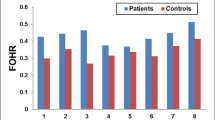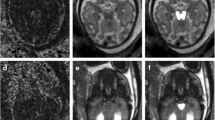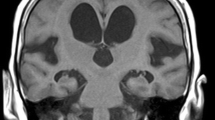Abstract
Background
Macrostructural abnormalities in cerebral white matter in patients with myelomeningocele are well known, but microstructural abnormalities are not as well studied.
Objective
The aim of this study was to evaluate cerebral white matter in adolescents with myelomeningocele using diffusion tensor imaging (DTI), and to investigate the effects of ventricular dilation and CSF shunt presence on white matter microstructure in these patients.
Materials and methods
DTI and T1-weighted 3-D (T1-3-D) MRI were performed on nine adolescents with myelomeningocele and Chiari II malformation and nine age-matched controls. The fractional anisotropy (FA) and mean diffusivity (MD) values were measured and compared.
Results
Significantly decreased FA and increased MD values were observed in most white matter regions and fibers in adolescents with myelomeningocele compared to controls. Further analysis in patients revealed significant changes in DTI parameters in hemispheres with enlarged lateral ventricles compared to those with normal ventricle size. In addition, a significant difference in FA values in the posterior limb of the internal capsule was found in the comparison of hemispheres in patients with or without CSF shunt catheters.
Conclusion
This study revealed widespread microstructural abnormalities in white matter in adolescents with myelomeningocele and Chiari II malformation. Ventricular dilation may have additional effects on white matter microstructure in this patient population. CSF shunt diversion effects on white matter may be multifactorial and need further investigation.



Similar content being viewed by others
References
Centers for Disease Control and Prevention (2009) Racial/ethnic differences in the birth prevalence of spina bifida—United States, 1995–2005. MMWR Morb Mortal Wkly Rep 57:1409–1413
Hunt GM (1990) Open spina bifida: outcome for a complete cohort treated unselectively and followed into adulthood. Dev Med Child Neurol 32:108–118
Fletcher JM, Northrup H, Landry SH et al (2004) Spina bifida: genes, brain, and development. International Review of Research in Mental Retardation, vol 29. Elsevier, San Diego, pp 63–117
Juranek J, Salman MS (2010) Anomalous development of brain structure and function in spina bifida myelomeningocele. Dev Disabil Res Rev 16:23–30
Basser PJ, Mattiello J, LeBihan D (1994) MR diffusion tensor spectroscopy and imaging. Biophys J 66:259–267
Pierpaoli C, Jezzard P, Basser PJ et al (1996) Diffusion tensor MR imaging of the human brain. Radiology 201:637–648
Song SK, Sun SW, Ju WK et al (2003) Diffusion tensor imaging detects and differentiates axon and myelin degeneration in mouse optic nerve after retinal ischemia. NeuroImage 20:1714–1722
Inder T, Huppi PS, Zientara GP et al (1999) Early detection of periventricular leukomalacia by diffusion-weighted magnetic resonance imaging techniques. J Pediatr 134:631–634
Nakayama N, Okumura A, Shinoda J et al (2006) Evidence for white matter disruption in traumatic brain injury without macroscopic lesions. J Neurol Neurosurg Psychiatry 77:850–855
Basser PJ, Pajevic S, Pierpaoli C et al (2000) In vivo fiber tractography using DT-MRI data. Magn Reson Med 44:625–632
Hasan KM, Eluvathingal TJ, Kramer LA et al (2008) White matter microstructural abnormalities in children with spina bifida myelomeningocele and hydrocephalus: a diffusion tensor tractography study of the association pathways. J Magn Reson Imaging 27:700–709
Hasan KM, Sankar A, Halphen C et al (2008) Quantitative diffusion tensor imaging and intellectual outcomes in spina bifida: laboratory investigation. J Neurosurg Pediatr 2:75–82
Herweh C, Akbar M, Wengenroth M et al (2009) DTI of commissural fibers in patients with Chiari II-malformation. Neuroimage 44:306–311
Kumar M, Gupta RK, Saksena S et al (2010) A diffusion tensor imaging study of deep gray and white matter brain maturation differences between patients with spina bifida cystica and healthy controls. J Clin Neurosci 17:879–885
Vachha B, Adams RC, Rollins NK (2006) Limbic tract anomalies in pediatric myelomeningocele and Chiari II malformation: anatomic correlations with memory and learning—initial investigation. Radiology 240:194–202
Alexander AL, Lee JE, Lazar M et al (2007) Diffusion tensor imaging of the brain. Neurotherapeutics 4:316–329
Nucifora PG, Verma R, Lee SK et al (2007) Diffusion-tensor MR imaging and tractography: exploring brain microstructure and connectivity. Radiology 245:367–384
Schmierer K, Wheeler-Kingshott CA, Boulby PA et al (2007) Diffusion tensor imaging of post mortem multiple sclerosis brain. Neuroimage 35:467–477
Klaas PA, Hannay JH, Caroselli JS et al (1999) Interhemispheric transfer of visual, auditory, tactile, and visuomotor information in children with hydrocephalus and partial agenesis of the corpus callosum. J Clin Exp Neuropsychol 21:837–850
Kunimatsu A, Aoki S, Masutani Y et al (2003) Three-dimensional white matter tractography by diffusion tensor imaging in ischaemic stroke involving the corticospinal tract. Neuroradiology 45:532–535
Assaf Y, Ben-Sira L, Constantini S et al (2006) Diffusion tensor imaging in hydrocephalus: initial experience. AJNR 27:1717–1724
McLone DG, Knepper PA (1989) The cause of Chiari II malformation: a unified theory. Pediatr Neurosci 15:1–12
Iddon JL, Morgan DJ, Loveday C et al (2004) Neuropsychological profile of young adults with spina bifida with or without hydrocephalus. J Neurol Neurosurg Psychiatr 75:1112–1118
Hattingen E, Jurcoane A, Melber J et al (2010) Diffusion tensor imaging in patients with adult chronic idiopathic hydrocephalus. Neurosurgery 66:917–924
Ulug AM, Truong TN, Filippi CG et al (2003) Diffusion imaging in obstructive hydrocephalus. AJNR 24:1171–1176
Yuan W, Mangano FT, Air EL et al (2009) Anisotropic diffusion properties in infants with hydrocephalus: a diffusion tensor imaging study. AJNR 30:1792–1798
Leliefeld PH, Gooskens RH, Braun KP et al (2009) Longitudinal diffusion-weighted imaging in infants with hydrocephalus: decrease in tissue water diffusion after cerebrospinal fluid diversion. J Neurosurg Pediatr 4:56–63
Air EL, Yuan W, Holland SK et al (2010) Longitudinal comparison of pre- and postoperative diffusion tensor imaging parameters in young children with hydrocephalus. J Neurosurg Pediatr 5:385–391
Tuli S, Drake J, Lamberti-Pasculli M (2003) Long-term outcome of hydrocephalus management in myelomeningoceles. Childs Nerv Syst 19:286–291
Kang JK, Lee IW (1999) Long-term follow-up of shunting therapy. Childs Nerv Syst 15:711–717
Lomax-Bream LE, Barnes M, Copeland K et al (2007) The impact of spina bifida on development across the first 3 years. Dev Neuropsychol 31:1–20
Hunt GM, Oakeshott P, Kerry S (1999) Link between the CSF shunt and achievement in adults with spina bifida. J Neurol Neurosurg Psychiatr 67:591–595
Foong J, Symms MR, Barker GJ et al (2002) Investigating regional white matter in schizophrenia using diffusion tensor imaging. Neuroreport 13:333–336
Smith SM, Jenkinson M, Johansen-Berg H et al (2006) Tract-based spatial statistics: voxelwise analysis of multi-subject diffusion data. Neuroimage 31:1487–1505
Ardekani S, Kumar A, Bartzokis G et al (2007) Exploratory voxel-based analysis of diffusion indices and hemispheric asymmetry in normal aging. Magn Reson Imaging 25:154–167
Bonekamp D, Nagae LM, Degaonkar M et al (2007) Diffusion tensor imaging in children and adolescents: reproducibility, hemispheric, and age-related differences. Neuroimage 34:733–742
Wilde EA, McCauley SR, Chu Z et al (2009) Diffusion tensor imaging of hemispheric asymmetries in the developing brain. J Clin Exp Neuropsychol 31:205–218
Acknowledgement
This research was supported, in part, by the University of Arkansas for Medical Sciences College of Medicine Children’s University Medical Group Grant Program.
Author information
Authors and Affiliations
Corresponding author
Rights and permissions
About this article
Cite this article
Ou, X., Glasier, C.M. & Snow, J.H. Diffusion tensor imaging evaluation of white matter in adolescents with myelomeningocele and Chiari II malformation. Pediatr Radiol 41, 1407–1415 (2011). https://doi.org/10.1007/s00247-011-2180-6
Received:
Revised:
Accepted:
Published:
Issue Date:
DOI: https://doi.org/10.1007/s00247-011-2180-6




